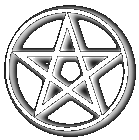|
{general information} {writings on paganism} {humor in religion} {convert me, if you dare} {pagan bookstore} {kaj's homepage} {kaj's cat's page} {kaj's "easy street" page} {pagan webrings} |

sabbats and celebrations:for a book with much more in-depth information on sabbats, please click here. autumn equinox: mabon (celtic), winter finding (teutonic), alban elfed (caledonii) around sept. 21at the autumn equinox, the days and nights are equal. it is a time of balance, but light gives way to increased darkness. it is the second harvest, and the goddess mourns her fallen consort, but the emphasis is on the message of rebirth that can be found in the harvest seeds. it is a good time to walk the forests, gathering dried plants for use as altar decorations or herbal magick. cornbread and cider are good additions to festivities and fall leaves make good altar decorations. samhain: shadowfest (strega), martinmas (celtic/scottish) october 31samhain, popularly known as halloween, is the witches' new year. It is said to be the time when the veil between the worlds is very thin, when souls that are leaving this physical plane can pass out and souls that are reincarnating can pass in. darkness increases and the goddess reigns as the crone, part of the "three-in-one" that also includes the maiden and mother. (note: i have my own beliefs, but this is what is traditionally believed in wicca.) the god, the dark lord, passes into the underworld to become the seed of his own rebirth (which will occur again at yule). many pagans prepare a feast for the dead on Samhain night, where they leave offerings of food and drink for the spirits. divination is heightened this night. jack-o-lanterns, gourds, cider, fall foliage can be used as altar decorations. yule: the winter solstice, yuletide (teutonic), alban arthan (caledonii) around dec. 21yule coincides closely with the christian christmas celebration. this sabbat represents the rebirth of light. here, on the longest night of the year, the goddess gives birth to the sun child and hope for new light is reborn. yule is a time of awakening to new goals and leaving old regrets behind. the christian tradition of a christmas tree has its origins in the pagan yule celebration. pagan families would bring a live tree into the home so the wood spirits would have a place to keep warm during the cold winter months. bells were hung in the limbs so you could tell when a spirit was present. food and treats were hung on the branches for the spirits to eat and a five-pointed star, the pentagram, symbol of the five elements, was placed atop the tree. the colors of the season, red and green, also are of pagan origin, as is the custom of exchanging gifts. a solar festival, yule is celebrated by fire and the use of a yule log. a piece of the log is saved and kept throughout the year to protect the home. that piece is used to light the next year's log. candlemas: imbolic (celtic), imbollgc brigantia (caledonii), lupercus (strega) february 2candlemas involves celebrations of banishing the winter and welcoming the spring. at the time of candlemas, the newborn sun god is seen as a small child nursing from his mother. at this phase of the cycle, winter is swept away and new beginnings are nurtured. some wiccan groups favor this time of year for initiations into the craft. it is traditional at candlemas to light every lamp in the house for a few minutes in honor of the sun's rebirth. ostara: vernal (spring) equinox, alban eiler (caledonii) around march 21the spring equinox is the point of equilibrium - the balance is suspended just before spring bursts forth from winter. the god and goddess are young children at play and holiday festivals use brightly colored eggs to represent the child within. the easter bunny also is of pagan origin, as are baskets of flowers. traditionally, ostara is a time for collecting wildflowers, walking in nature's beauty and cultivating herb gardens. this is the time to free yourself from anything in the past that is holding you back. beltane: mayday, bealtinne (caledonii), | ||||||
